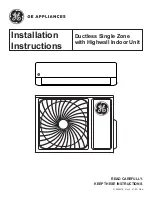
IM 422 / Page 13 of 28
Installing Room Cabinet
The room cabinet is the last piece to install. The following
instructions assume all components (wall sleeve, heat section,
louver and chassis) have been installed, piped and anchored.
All major room construction should also be complete so as not
to damage the room cabinet after it has been installed. Attach-
ing the room cabinet can be completed as follows:
1. Firmly grasp the room cabinet and lift it over the heat section.
There are notches in the back flanges of the room cabinet
that rest on the wall sleeve to assure it is centered.
2. Align the notches of the room cabinet on the wall sleeve and
firmly push the cabinet downward until it seats on the wall
sleeve (see Figure 25).
3. Screw the cabinet to the wall using the screws provided.
There are two (2) screw holes provided on each side located
on the inner flanges of the room cabinet.
4. Loosen the four (4) wing nuts on the kickplate and adjust the
kickplate the required distance to the floor.
5. Tighten the wing nuts firmly.
6. Wipe any smudges or dirt off the room cabinet using a mild
cleaner and a soft cloth.
All wiring should be in accordance with all local and National
Electrical Code requirements.
Units are supplied with an attachment cord and plug which
exit from the bottom of the conditioner on the control side. The
cord for 115V, 208V and 230V has a usable length of 72"
(1829mm) from where it exits the conditioner. The use of
extension cords to increase the length of the plug/cord set is not
recommended. Units to operate on 265V are supplied with a
Electrical Service
14" (356mm) cord for connection to a subbase.
The attachment plug size should be used to determine the
circuit ampacity and overcurrent protection. Time delay,
overcurrent protection devices are recommended to prevent
unit damage and to avoid nuisance tripping.
Outlets are generally located beneath the conditioner, on
or recessed in the wall so it is concealed by the conditioner
overhang and kickplate.
Optional Adjusting Temperature Limiting Device
As an option, a temperature limiting device can be furnished to
allow the owner to set the minimum and/or maximum tempera-
ture selections. Adjust this device as follows:
1. Remove temperature knob and metal cover plate.
2. Loosen the hold-down screw with Phillips screwdriver.
3. Adjust cams to attain desired rotation limit.
4. Tighten hold-down screw.
5. Replace metal cover and temperature knob.
Once unit is in operation, rotate knob to maximum heat
and/or maximum cool to check temperature limits. Repeat
procedure listed above until desired temperature limitations
are achieved.
Figure 25.
Содержание Incremental PDNC Series
Страница 20: ...IM 422 Page 20 of 28 PDNS PDNC Wiring Diagram Unit Mounted Digital Touch Pad Control First Release...
Страница 21: ...IM 422 Page 21 of 28 Wiring Diagram PDNS PDNC Control Remote Thermostat N O Valve 24V...
Страница 22: ...IM 422 Page 22 of 28 Wiring Diagram PDNS PDNC Control Unit Mounted N O Valve 24V...
Страница 23: ...IM 422 Page 23 of 28 Wiring Diagram PDNS PDNC Chassis Wiring...
Страница 24: ...IM 422 Page 24 of 28 Wiring Diagram PDNS PDNC Control Remote Thermostat N C Valve 24V...
Страница 25: ...IM 422 Page 25 of 28 Wiring Diagram PDNS PDNC Unit Mounted Thermostat Manual Changeover N C Valve...
Страница 26: ...IM 422 Page 26 of 28 Wiring Diagram PDNS PDNC Control Unit Mounted with HFLO Fan Cycle on Heat N C Valve 24V...
Страница 27: ...IM 422 Page 27 of 28 Wiring Diagram PDNS PDNC Unit Mounted Thermostat Manual Changeover N C Valve...














































